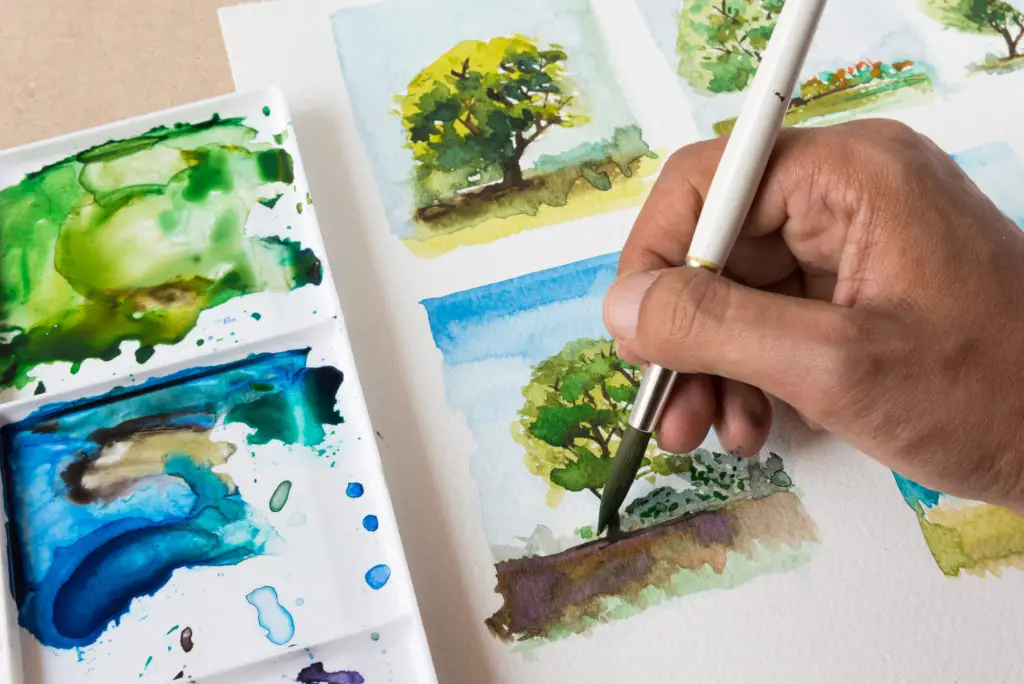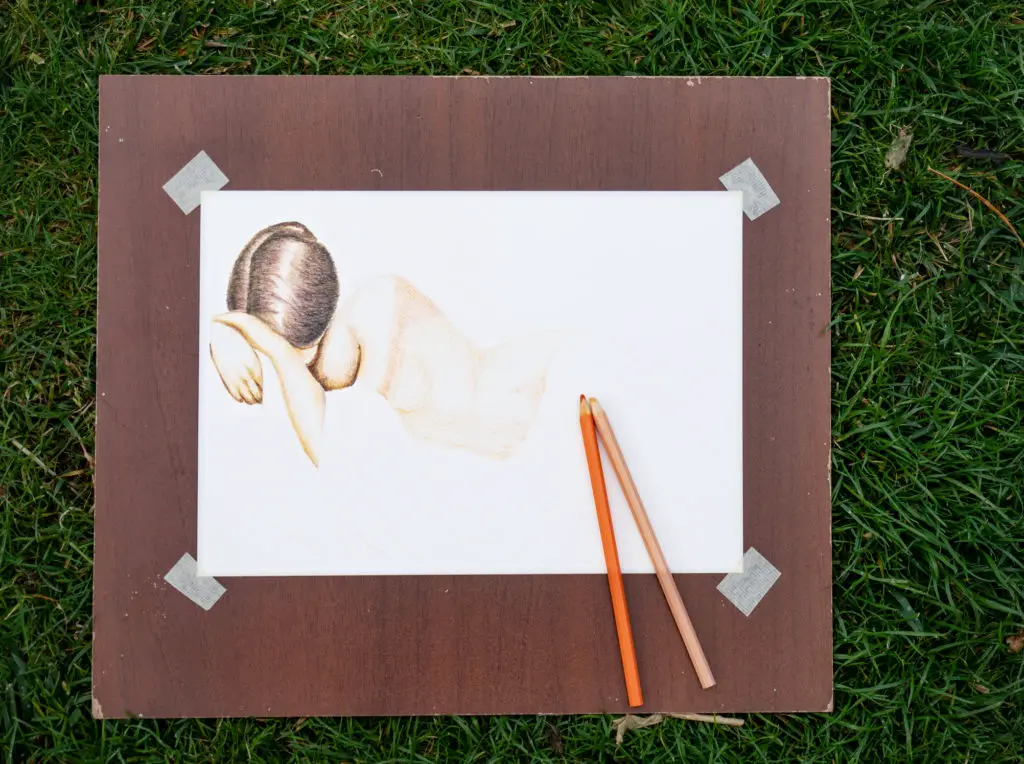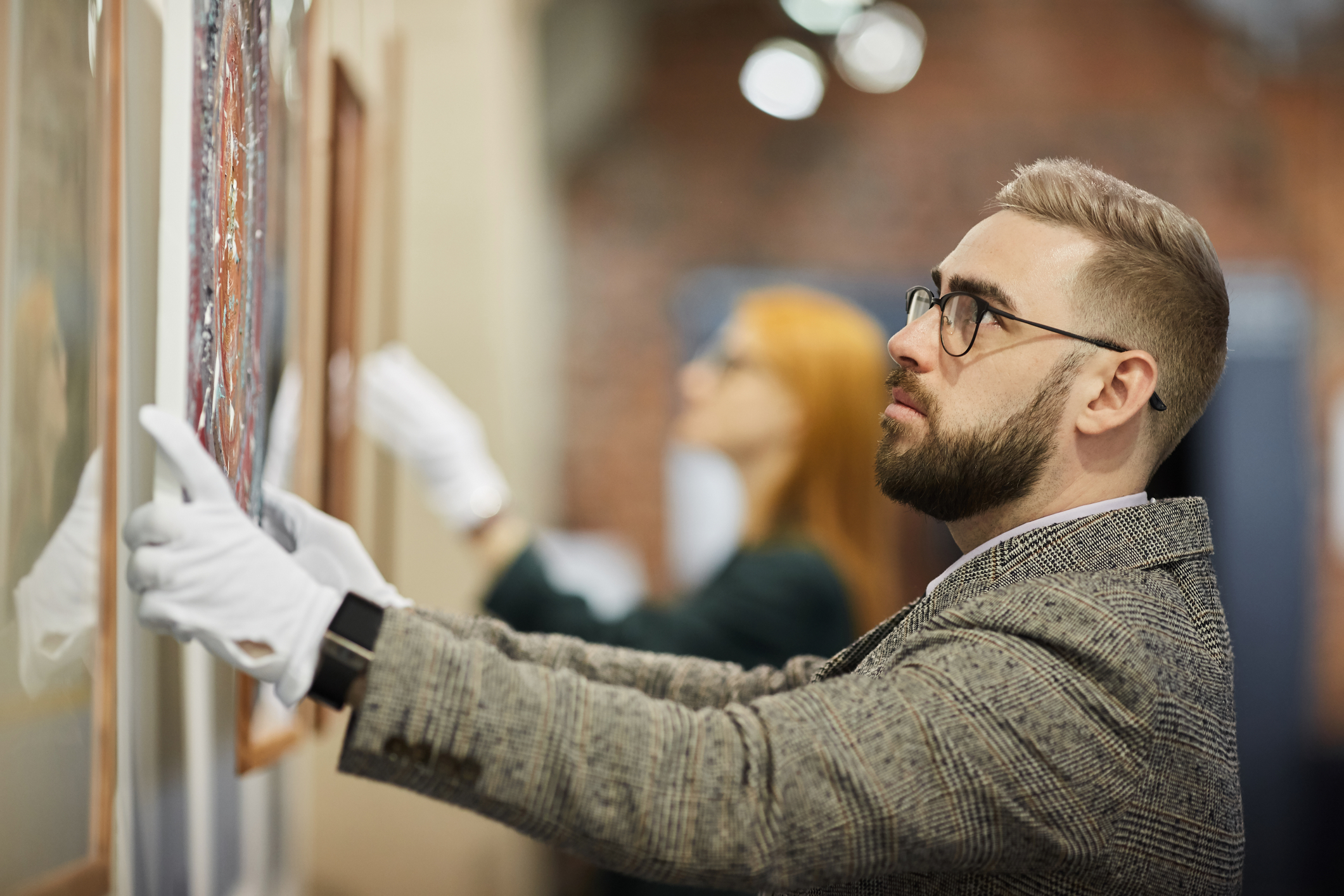So, you’ve invested in a great piece of wall art, and you want to give it a good home. Your first instinct may be to run your hand over it, get a feel for it, and develop a better sense of the piece. But you might want to hold off on this until you learn how to handle artwork.
To handle artwork safely, it’s best to put on clean, white cotton gloves. Inspect the piece where you plan to grasp to ensure no damage will occur. Hold the art securely by its outer edges, stretcher, or frame. Minimize contact in general. For larger pieces, use an assistant or a moving dolly, or a hand truck.
These measures might seem extreme for a budget artwork, but good habits apply to all art handling. An inexpensive art piece from an emerging artist might not be valuable today. Still, its value could one day skyrocket, assuming it remained clean and was handled as an investment. Negligent handling can depreciate the artwork.

Protective Gear for Handling Artwork
Wearing white cotton gloves should always be a priority when handling wall art. These gloves will allow you to grasp the art safely while minimizing damage to it.
Protective gear is not only a way to protect your art piece from dirt and damage but can also protect you in some cases. Some wall art may have sharp and fragile edges that could potentially cut or bruise you.
Other protective gear like face masks and hairnets are only used when handling extremely high-value art for restoration or analysis procedures. You can see these extremes are required to preserve some high-value artwork and historical documents when looking at how the Declaration of Independence is preserved and moved. However, when handling your art on your own, using only white cotton gloves is sufficient.
The average home collector may even find wearing gloves unnecessary when handling personal art pieces. Wearing protective gear then becomes a personal decision, and it’s one based on how carefully you want to handle your wall art and its value.
Know the Medium of the Artwork
Knowing how different art mediums react to your touch will help you make a more educated decision to handle your wall art. We often hear, “please don’t touch the art,” but why?
The oils from your skin could leave an acidic residue on any material you touch. These oils can’t be easily wiped off with a rag or a brush and will need more in-depth cleaning that can damage your wall art. While one fingerprint won’t necessarily ruin art, a buildup can form, and a bad habit of touching your art too much can damage it in the long run.

Watercolor paintings and metals are especially susceptible to greasy fingerprints.
Different mediums have unique requirements on how to properly handle them. Oil paintings have a brittle surface, making them very sensitive to the pressure of your touch. Depending on the oil painting’s age, just a touch can be enough for the paint to flake off. The same goes for acrylic paintings.
Textiles are usually less sensitive to damage from the oils on your skin. But this medium still needs to be handled with care and respect to preserve its color and quality. Handling textiles too much can lead to the fibers fraying or even cause discoloration.
Handling Canvas-Based Media
An unframed canvas can be hard to handle and move around. You should, however, take care to carry a canvas by its wood stretcher and avoid touching the canvas or painted surface with your bare hands. Place your thumb on top of the wood stretcher and your fingers underneath. You can use both hands if the canvas is heavier by gripping the wood stretcher on both sides.
An unmounted canvas that is not secured to a stretcher will be more sensitive to move around, depending on if it can be rolled up or not. If not, be careful not to bump into anything while carrying the canvas as you securely grip the unmounted canvas by two of its corners.
Try to avoid rolling canvas artwork. Although a rolled-up canvas is easier to carry around because of its smaller size, this is prone to damage the art, especially older work.
If rolling is okay, ensure to roll the canvas with the painted side facing outward to avoid compression as oil paintings can stretch slightly but not compress. Use a sheet of glassine paper over and under the painting as you roll it loosely around a solid core like a PVC tube.
The goal of handling canvases is to avoid touching the painted areas of the canvas as much as possible. Touch and carry the canvas only where there is no paint.
By the way:
Bubble wrap is great for framed and glass art, but glassine paper is a safer choice otherwise. We have a guide on how to ship artwork and what packing materials to use.

Handling Paper Artworks
Artwork made on paper, such as drawings, will need more careful handling, depending on its quality and condition. Older and thinner paper is more fragile than newer and thicker paper. The goal is not to damage the artwork or the paper when handling paper artwork.
Avoid touching the drawn or painted surface of the paper; instead, hold it by its top or bottom edges. Carry the paper with light pressure from your gloved hands. A smaller paper artwork can even be carried on its back by resting it on your fully extended hand.
You can opt to roll the paper into a soft roll if you know this won’t damage the artwork. Water-colored paintings on paper can usually be rolled up. Still, thicker paints like acrylics or oils are not as flexible. Drawings are easier to roll, but be wary of smudging the drawing surface.
Handling Wood Panel Artworks
Carrying a wood panel painting should be done with minimal touching of the painted areas.
Hold the artwork on opposite sides with both hands, just like you carry frames. Depending on the weight of the wood panel, you can grip it on the sides. For heavier work, support the piece with one cupped hand underneath the bottom edge and one on the side.
You might want to handle wood panel paintings with white cotton gloves, just like any other painting.
Handling Photographs
It is pretty easy to leave fingerprints on the surface of photographic prints. Their sensitivity to grease from your hands is why you need to be careful to have clean hands when handling photographs. And again, it’s preferable to wear white cotton gloves.
Smaller photographs can be held between your thumb and index finger on each side, pinching only a small print area. Larger pictures should only be touched on the extreme edges.
Make sure you wear microfiber or nitrile gloves that are non-scratching. Nitrile gloves are powder-free sterile gloves to prevent scratching.
The easiest and safest way to handle photographs is to frame them. While glass can be easily be cleaned, many photographic materials cannot.
Handling Framed Artworks
Much like handling wood panel art, framed art should be carried by placing a hand on each side of the frame. Alternatively, use a cupped hand supporting the bottom edge and a side hand for controlling the artwork vertically.
Carrying a framed art piece by the mounting wire is not advised. The lack of multidirectional control may lead to accidental damage. These hanging wires are designed for walls or mounting surfaces that do not move. Wires can unravel, and the eyelets can pull from the frame while in motion.

Professional Help
Professional art handlers work in art galleries and museums to make sure art is safely handled and cared for. They pack and unpack, mount and unmount, or move art as a service. These art professionals know how to handle different art types and understand how to come up with creative solutions.
Whether you’re moving a piece from one wall to another or you need a moving truck with a courier service to send a piece to a buyer, a professional art handler may be the way to go for valuable artwork. They will know what to do and how to care for your piece. This care is especially important for larger works which can be especially tricky to mount and unmount, pack away or unpack, or move around.
Untrained family, friends, or neighbors are usually happy to help for free. But, if the care is of the utmost importance for your hanging investment, let a professional art handler do it for you with their team.



